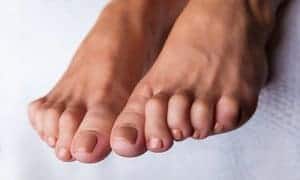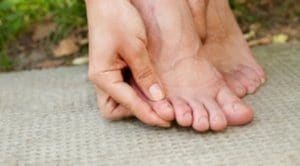
What causes hammertoe and mallet toe?

- Poorly fitting footwear: any shoes or boots which don’t allow the toes to lie flat have the potential to cause either deformity. Overly tight toe boxes are also major contributors. Note that high-heeled shoes are notorious for causing these conditions and several others.
- Injury: trauma such as a severely stubbed toe can set a patient up for hammer or mallet toe. Poorly set fractures can also play a role.
- Abnormal toe musculature: this can cause poor biomechanics which can lead to a host of foot conditions. This includes the deformities mentioned above.
Common risk factors for hammertoe
Some patients are much more likely to develop foot deformities than others. Common risk factors include:
- Age: hammertoe and mallet toes occur much more frequently in the 5th-7th decades.
- Gender: females are more prone to these conditions than males. The exact reasons for this are unknown.
- Length of toes: individuals with a 2nd toe that’s longer than the big toe are at an elevated risk.
- Systemic diseases: those with certain types of arthritis are more prone to developing these deformities. This includes osteoarthritis and rheumatoid arthritis. Diabetes can also be a contributing factor..
- Heredity: if you have a close relative with hammertoes or mallet toes you may be affected as well.
Some Simple Tips To Get Relief From Hammertoes
Did you know that if your hammer toe is mild then some home remedies can help you cure it and prevent it from getting worse?
If your toe is still flexible then there are chances that you can still save it but once it becomes thick there is no going back, only surgery is your option.
So make sure you don’t ignore hammer toes as they can be hard to treat later, here are some tips to get relief from hammer toes:
1. Exercise Your Toes Daily
For a mild hammer toe this this tip is really help full!
If you can still move your toe then start exercising it every day. You can try some stretches or do any exercise that increases the muscle strength of your toe.
If your toe stays active then it will be really easy for you to prevent this problem.
You can ask your doctor more about these exercises, they will surely help you and this way you won’t have to deal with surgery.
2. Change The Pair Of Your Shoes
Wrong type of shoes are the leading cause of hammer toes, so you must buy the right ones.
Make sure the shoes you buy provide a lot of space for your toes, if you don’t get enough space your toes will stick together or contract which puts you at a risk of mallet toes.
3. Surgery
In most cases surgery is the last option, if nothing else works then you will need the surgery.
But your doctor directly won’t recommend you a surgery if your toe is still flexible then then they may recommend another treatment.
However, even if they recommend the surgery don’t worry since its for your own good and from next time make sure to take care of your toes.
Complications of hammertoe and associated deformities
In its early stages a hammer or mallet toe will usually have some flexibility. In later stages, especially without early treatment, the tendons which cross the toe joints become permanently contracted. This in turn permanently fixes the toe into an abnormal position. At this point surgery is often the only viable option for re-straightening the toe.
Once the deformity becomes permanent the raised portion of the toe tend to rub against the patient’s shoe. This leads to repetitive friction which can cause blisters, corns, and calluses which range from mildly uncomfortable to outright painful. Can often be easily corrected in the office in a 15 minute procedure, allowing you to walk out with a light dressing.
How do age and genetics play a role in the development of hammer toe and mallet toe?
Age and genetics can both play significant roles in the development of hammer toe and mallet toe:
- Age: As people age, the ligaments and tendons in their feet may weaken or become less flexible, leading to changes in foot structure and function. Additionally, the natural aging process can result in a loss of fat pads in the ball of the foot, which can contribute to the development of hammer toe and mallet toe.
- Genetics: There is evidence to suggest that genetics can predispose individuals to certain foot deformities, including hammer toe and mallet toe. If a person’s parents or other close relatives have had these conditions, they may be more likely to develop them as well.
- Foot Mechanics: Certain foot structures or biomechanical abnormalities, which can be inherited, may increase the risk of developing hammer toe and mallet toe. For example, having a high arch or flat foot can alter the distribution of weight on the foot and contribute to toe deformities.
Can hammer toe and mallet toe lead to other foot problems?
Yes, hammer toe and mallet toe can lead to other foot problems if left untreated. Some potential complications and related foot problems associated with hammer toe and mallet toe include:
- Corns and Calluses: The abnormal toe positions in hammer toe and mallet toe can cause friction and pressure against the inside of shoes, leading to the formation of corns and calluses. These can be painful and may require treatment to alleviate discomfort.
- Bursitis: Inflammation of the bursa, a fluid-filled sac that cushions and lubricates joints, can occur in the affected toes due to constant rubbing against shoes. This can cause pain, swelling, and redness in the affected area.
